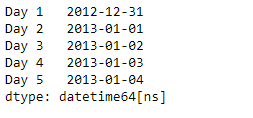Python| Pandas Series.dt.tz_localize
Series.dt可用于以 datetimelike 的形式访问系列的值并返回多个属性。 Pandas Series.dt.tz_localize()函数将 tz-naive Datetime Array/Index 本地化为 tz-aware Datetime Array/Index。此方法采用时区 (tz) 天真 Datetime Array/Index 对象,并使该时区感知。它不会将时间移动到另一个时区。
Syntax: Series.dt.tz_localize(*args, **kwargs)
Parameter :
tz : Time zone to convert timestamps to.
Returns : same type as self
示例 #1:使用Series.dt.tz_localize()函数将系列中的 tz-naive 日期时间值本地化为 tz-aware。
# importing pandas as pd
import pandas as pd
# Creating the Series
sr = pd.Series(['2012-12-31', '2019-1-1 12:30', '2008-02-2 10:30',
'2010-1-1 09:25', '2019-12-31 00:00'])
# Creating the index
idx = ['Day 1', 'Day 2', 'Day 3', 'Day 4', 'Day 5']
# set the index
sr.index = idx
# Convert the underlying data to datetime
sr = pd.to_datetime(sr)
# Print the series
print(sr)
输出 :

现在我们将使用Series.dt.tz_localize()函数将给定的 tz-naive 系列本地化为“美国/东部”。
# localize to 'US / Eastern'
result = sr.dt.tz_localize(tz = 'US / Eastern')
# print the result
print(result)
输出 :

正如我们在输出中看到的那样, Series.dt.tz_localize()函数已成功将给定的 tz-naive 日期时间序列本地化为 tz-aware。
示例 #2:使用Series.dt.tz_localize()函数将给定的系列对象作为原生Python日期时间对象的数组返回。
# importing pandas as pd
import pandas as pd
# Creating the Series
sr = pd.Series(pd.date_range('2012-12-31 00:00', periods = 5, freq = 'D'))
# Creating the index
idx = ['Day 1', 'Day 2', 'Day 3', 'Day 4', 'Day 5']
# set the index
sr.index = idx
# Print the series
print(sr)
输出 :

现在我们将使用Series.dt.tz_localize()函数将给定的 tz-naive 系列本地化为“Europe/Berlin”。
# localize to 'Europe / Berlin'
result = sr.dt.tz_localize(tz = 'Europe / Berlin')
# print the result
print(result)
输出 :

正如我们在输出中看到的那样, Series.dt.tz_localize()函数已成功将给定的 tz-naive 日期时间序列本地化为 tz-aware。